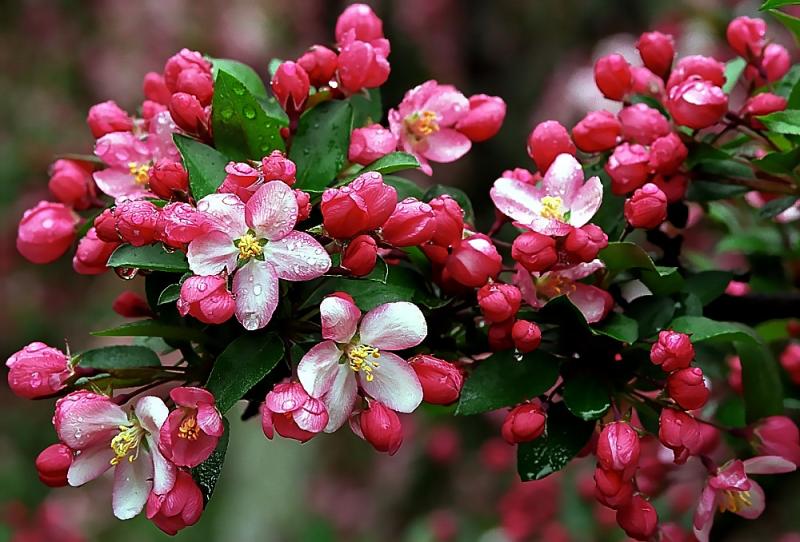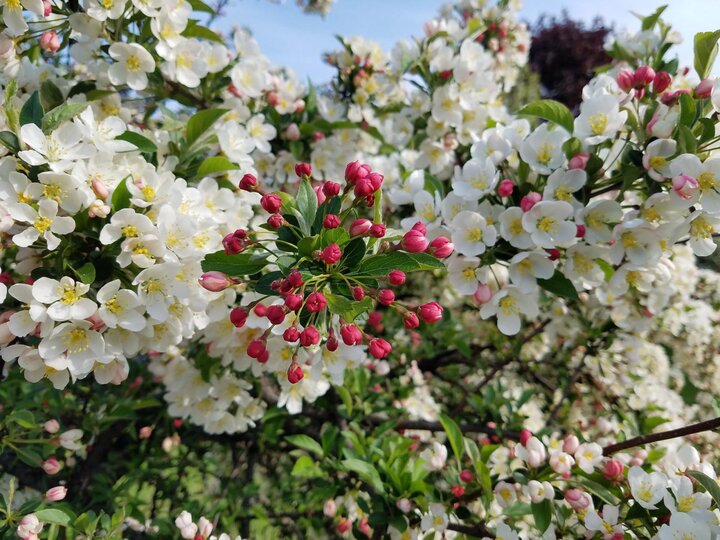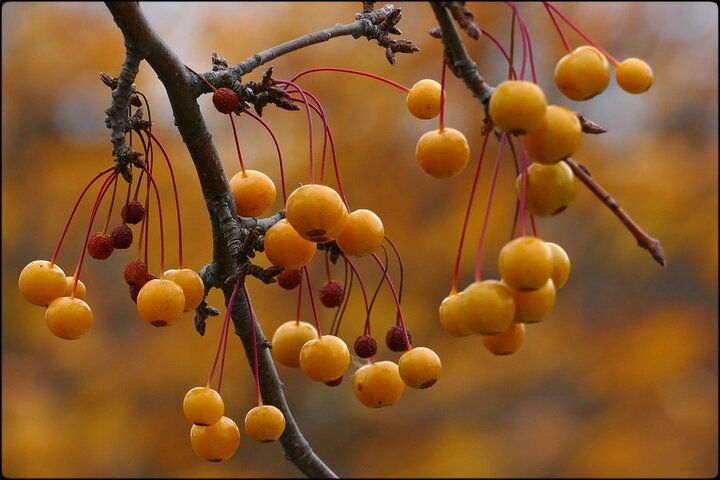
Crabapple flowers add vibrant color to the spring landscape. Credit - "Cincinnati - Spring Grove Cemetery & Arboretum 'Hamlet Red Crabapple'" by David Paul Ohmer is licensed under CC BY 2.0
Now that trees have dropped their leaves, and fall leaf coloration is done, one of my favorite sights for late fall and winter is a crabapple tree loaded with fruit. Maybe it’s just that the leaves are gone and the fruits are easier to see, but it seems to me that some crabapples develop deeper, more intense coloration after a few light frosts. My favorites are trees covered with hundreds of small, colorful fruits.
Unlike the flowers, which last only a few weeks, fruit color is effective for months, throughout winter on some cultivars. Crabapples may be purple, red, yellow or orange-red, and vary in size from ¼ inch to 2 inches across. Trees covered with small fruits create a very colorful display, and while the larger-sized fruit may pose a litter problem, they can be harvested and make delicious jelly. Or you can use a few branches as colorful additions to fall or holiday arrangements.
Birds, such as the cedar waxwings and robins, also love crabapples, feeding most often on the smaller fruited cultivars.

Hundreds of crabapple cultivars are available in the landscaping market, but here are a few great cultivars for Nebraska landscapes. Most crabapples mature between 15 to 25 feet tall, although cultivars as small as 8 feet or as tall as 40 feet are available. Tree form or shape varies from tall and narrow, through oval to round. Cultivars such as 'Molten Lava' and ‘Red Jade’, which have an interesting spreading/weeping form, are particularly attractive in winter.
Most crabapples have single flowers, although a few cultivars have additional petals (semi-double or double blossoms). Even in the ballooning stage, which occurs in spring as buds enlarge and develop color but before blossoms are fully open, they are attractive. Colors in the balloon stage are white, pink, or red. Once fully open, the blossoms become fragrant. The total bloom period may be as long as two weeks although wind, heat and rain can shorten this. Most crabapples flower a few years after planting.
Crabapples are susceptible to all the common diseases found in apples, including cedar-apple rust, apple scab, powdery mildew and fire blight. To avoid ugly trees with excessive leaf loss in late summer or branch dieback, it’s important to choose cultivars with good disease resistance such as those below. Talk with your local nursery about availability.

- Lancelot – red buds, upright oval canopy, 10’ height x 8’ width, golden yellow fall foliage color, 3/8” persistent gold fruits
- Lollipop – rounded compact canopy, 10’ height x 10’ width, ½” yellow persistent fruits
- Ormiston Roy – rose red flower buds, round to upright canopy, 20’ height x 25’ width, 3/8” persistent orange-red fruits, excellent resistance to Japanese beetles
- Professor Sprenger – red to pink flower buds, ½” orange-red persistent fruits, upright canopy, 20’ height x 20’ width, dark green foliage
Image White flowers, red fruits
- David – light pink buds, rounded compact tree, 12’ height x 15’ width, dark green foliage, ½” scarlet fruits, good Japanese beetle resistance
- Dolgo – pink buds, open rounded canopy, 30’ height x 40’ width large 1.5” bright reddish-purple fruits fall early, can be used for jelly
- Mary Potter – dark pink buds, alternate year flower production, spreading low-branched crown, lustrous dark green foliage, sometimes yellow gold fall color, 15’ height x 20’ width, ½” red fruits, excellent Japanese beetle resistance
- Donald Wyman – red to pink buds, large spreading canopy, 20’ height x 25’ width, lustrous dark green foliage, glossy bright red ½” fruits
- Molten Lava – deep red buds, wide-spreading weeping canopy, 15’ height x 12’ width, 3/8” red-orange fruits, excellent Japanese beetle resistance
- Red Jade – deep pink buds, weeping canopy, 15’ height, ½” glossy red fruits
- Sargentii – red buds, spreading/shrubby tree, 8’ height x 12’ width, dark red ½” fruits, blooms heavily in alternate years, excellent Japanese beetle resistance
- Sugar Tyme – pale pink buds, upright oval canopy, 18’ height x 15’ width, crisp dark green foliage, ½” persistent fruits, good Japanese beetle resistance
- Tina – red buds, dwarf with low spreading canopy, 5’ height x 10’ width, 5/16” red fruits
- White Angel – pink buds, rounded canopy, 20’ height x 20’ width, lustrous dark green foliage, ½-3/4” glossy red fruits, heavy fruit producer
Pink flowers
- Adams – carmine buds, rounded canopy, reddish new foliage,;24’ height x 24’ width, 5/8” glossy dark red persistent fruits, poor Japanese beetle resistance
- CoralBurst – semi-double coral pink buds, compact rounded canopy, 15’ height x 10’ width, small dark green leaves, sparse ½” bronze fruits
- Royal Raindrops – upright spreading canopy, 15’ height x 12’ width, purple foliage turns orange-red in fall, tiny ¼ inch maroon-red persistent fruits
- Strawberry Parfait – red buds, vase-shaped canopy, purple-tinged new leaves become leathery dark green, 20’ height x 25’ width, ½” yellow fruits with a red blush, excellent Japanese beetle resistance
Red flowers
- Liset – dark crimson buds, rounded canopy, 15’ height x 20’ width, deep purplish-green foliage, ½” maroon red persistent fruits
- PrairiFire – red buds opening to dark purplish-red flowers, spreading canopy, 20’ height x 20’ width, ½” purple-red persistent fruits
- Profusion – deep red buds opening to violet red flowers, vase-shaped canopy, 20’ height x 20’ width, reddish-purple new leaves change to bronze-green, ½” oxblood red persistent fruits
Site Selection & Planting
Crabapples are a great option for a small blooming ornamental tree in Nebraska. Crabapples are adapted to a wide range of soil types, including heavy loams although the soil should be well drained. They prefer a soil pH between 6.0-6.8 (slightly acid), although they are very adaptable to more alkaline soil, too. But plant them where they'll receive full sun for maximum flower production and to minimize the potential for powdery mildew.
Plant trees at the proper depth, with the trunk flare evident at the soil line and the first main root just below the soil surface. Making sure that trees are not planted too deeply will also minimize the production of suckers, but if suckers develop prune them out as needed.
Water sprouts, or very fast growing upright shoots on the scaffold branches, should be removed to allow air and light into the tree's center. The majority of pruning for good structure or shape should be done before mid-June in crabapples to avoid removing next year's flower buds.
Images
- Crabapple flowers are often a different color than they first appear when in the bud. Image from Pixabay.
- Crabapple fruits add much-needed color to the late fall and winter landscape. Credit -"crabapples in fall" Ken Mattison is licensed under CC BY-NC-ND 2.0
- Large-fruited crabapples can be harvest and used to make jam or jelly. Image from Pixabay.
Search Our Archive
Associated Video
Green and Growing Tip: Flowering Crabapple
Nebraska Extension Landscape Horticulture Specialist Kim Todd discusses what to do to keep your flowering crabapples healthy and growing